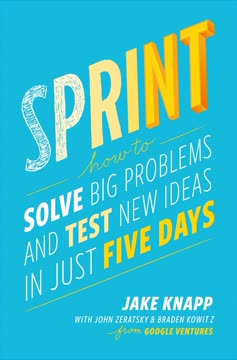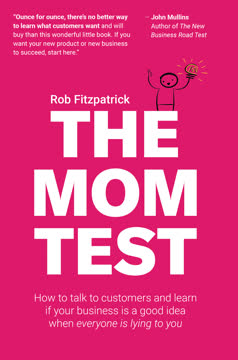Key Takeaways
Traction is the key to startup success
Traction trumps everything.
Quantitative evidence of demand. Traction is the measurable progress that demonstrates customer demand for your product or service. It's the lifeblood of startups, providing tangible proof that your business is viable and growing. Traction can take many forms, such as:
- User signups or active users
- Revenue growth
- Customer acquisition metrics
- Press coverage and media mentions
Crucial for various stakeholders. Traction is essential for attracting investors, hiring top talent, and securing partnerships. It provides the momentum needed to overcome early challenges and reach critical mass. Without traction, even the most innovative ideas can falter.
The Bullseye Framework optimizes traction channel selection
The goal in brainstorming is to come up with reasonable ways you might use each traction channel.
Systematic approach to traction. The Bullseye Framework is a five-step process for identifying and focusing on the most effective traction channels for your startup:
- Brainstorm: Generate ideas for all 19 traction channels
- Rank: Categorize channels into three rings (inner circle, promising, long-shot)
- Prioritize: Select the top three channels for testing
- Test: Run cheap tests to validate assumptions
- Focus: Double down on the most effective channel
Overcoming biases. This framework helps founders overcome their natural biases towards certain channels and encourages exploration of all potential avenues for growth. By systematically evaluating each channel, startups can discover unexpected opportunities for traction.
Balance product development with traction efforts
If you're starting a company, chances are you can build a product. Almost every failed startup has a product. What failed startups don't have are enough customers.
The 50% rule. Dedicate equal time and resources to product development and traction efforts. This balanced approach ensures that you're not only building something people want but also figuring out how to reach those people effectively.
Parallel development benefits:
- Gather valuable market feedback to inform product decisions
- Identify potential customers and partners early
- Build an audience before launch
- Validate assumptions about customer acquisition
By pursuing traction alongside product development, startups can avoid the common pitfall of building a product in isolation and struggling to find customers after launch.
Test and measure to find your optimal traction channel
The goal of this step is to find out which of the traction channels in your inner circle is worth focusing on.
Data-driven decision making. Conduct small-scale tests across multiple traction channels to gather data on their effectiveness. Key metrics to measure include:
- Customer acquisition cost (CAC)
- Conversion rates
- Scalability potential
- Target audience reach
Continuous optimization. Once you've identified a promising channel, focus on optimizing its performance through:
- A/B testing of marketing messages, visuals, and tactics
- Refining target audience segments
- Improving conversion funnels
- Scaling successful strategies
Remember that traction channels may evolve as your startup grows, so regularly reassess and adapt your approach.
Viral marketing can fuel exponential growth
The viral coefficient, or K, is number of additional users you can get for each user you bring in.
Understanding viral loops. Viral marketing leverages existing users to acquire new ones through referrals, sharing, or word-of-mouth. The viral coefficient (K) determines the growth rate:
- K > 1: Exponential growth
- K = 1: Linear growth
- K < 1: Sublinear growth
Optimizing for virality:
- Reduce friction in the sharing process
- Provide clear incentives for referrals
- Create shareable content or experiences
- Leverage network effects
- Continuously test and refine viral loops
Successful viral marketing campaigns can lead to rapid, cost-effective user acquisition. However, it's crucial to balance virality with user experience and product value to ensure sustainable growth.
Content marketing builds authority and attracts customers
Creating engaging social experiences is another way to succeed on social sites.
Valuable, shareable content. Content marketing involves creating and distributing valuable, relevant content to attract and engage a target audience. Effective content marketing:
- Establishes thought leadership and industry expertise
- Drives organic traffic through search engine optimization (SEO)
- Builds trust and credibility with potential customers
- Provides value beyond your product or service
Content marketing strategies:
- Blog posts and articles
- Whitepapers and ebooks
- Infographics and visual content
- Videos and podcasts
- Social media content
- Email newsletters
Consistency and quality are key to successful content marketing. Focus on addressing your audience's pain points and providing actionable insights to build a loyal following.
Sales and business development drive B2B traction
Business development is like sales with one key distinction: it is primarily focused on exchanging value through partnerships, whereas sales primarily focuses on exchanging dollars for a product.
Direct customer acquisition. Sales involves directly engaging potential customers to convert them into paying users. Effective sales strategies include:
- Identifying and qualifying leads
- Developing a repeatable sales process
- Building relationships with decision-makers
- Addressing objections and demonstrating value
Strategic partnerships. Business development focuses on creating mutually beneficial relationships with other companies to drive growth. Types of partnerships include:
- Distribution deals
- Product integrations
- Co-marketing agreements
- Licensing arrangements
Both sales and business development require a deep understanding of your target market and the ability to communicate your value proposition effectively.
Existing platforms offer rapid growth opportunities
There are thousands of other large sites and marketplaces that you can target to get users.
Leveraging established user bases. Existing platforms like app stores, social networks, and marketplaces provide access to large, engaged audiences. Benefits of platform-based growth include:
- Reduced customer acquisition costs
- Built-in distribution channels
- Potential for viral growth
- Access to platform-specific features and data
Platform strategies:
- Develop platform-specific features or integrations
- Optimize for platform discovery (e.g., App Store optimization)
- Leverage platform APIs and SDKs
- Participate in platform-specific marketing programs
- Build relationships with platform gatekeepers
When targeting existing platforms, focus on providing unique value that complements the platform's core offerings while addressing user needs.
Public relations and unconventional PR generate buzz
PR has a huge impact on early stage startups.
Media coverage and brand awareness. Public relations involves managing your startup's public image and securing media coverage to build credibility and attract attention. Effective PR strategies include:
- Developing compelling story angles
- Building relationships with journalists and influencers
- Creating newsworthy events or milestones
- Leveraging data and industry insights
- Responding to relevant news and trends
Unconventional PR tactics. Think outside the box to generate buzz and capture attention:
- Publicity stunts
- Viral marketing campaigns
- Guerrilla marketing tactics
- Creative social media challenges
- Unique customer appreciation initiatives
Both traditional and unconventional PR can help startups stand out in crowded markets and build brand recognition with limited budgets.
Offline events and trade shows facilitate direct customer engagement
Trade shows give you more direct interaction with customers, partners, and press in a short period of time than most other traction channels.
Face-to-face connections. Offline events and trade shows provide opportunities to interact directly with potential customers, partners, and industry influencers. Benefits include:
- Building personal relationships
- Demonstrating products in person
- Gathering immediate feedback
- Networking with industry peers
- Generating leads and closing deals
Event strategies:
- Host your own conferences or meetups
- Sponsor relevant industry events
- Deliver keynote speeches or participate in panels
- Create engaging booth experiences
- Organize VIP dinners or networking sessions
While offline events can be resource-intensive, they offer unique opportunities for deep engagement and relationship-building that are difficult to replicate through digital channels alone.
Last updated:
FAQ
What's "Traction: A Startup Guide to Getting Customers" about?
- Focus on Traction: The book emphasizes the importance of gaining traction for startups, which means achieving significant growth and customer acquisition.
- 19 Traction Channels: It introduces 19 different channels through which startups can gain traction, such as viral marketing, SEO, and business development.
- Bullseye Framework: The authors present a systematic approach called the Bullseye Framework to help startups identify the most promising traction channels.
- Practical Advice: The book is filled with interviews and case studies from successful entrepreneurs, providing practical strategies and tactics for gaining traction.
Why should I read "Traction: A Startup Guide to Getting Customers"?
- Comprehensive Guide: It offers a comprehensive guide to understanding and implementing various customer acquisition strategies.
- Real-World Examples: The book includes insights from over 40 successful founders, making the advice practical and relatable.
- Actionable Frameworks: It provides actionable frameworks like the Bullseye Framework and Critical Path to help startups systematically gain traction.
- Versatile Application: Whether you're in the early stages or scaling, the book's strategies are applicable to a wide range of startups.
What are the key takeaways of "Traction: A Startup Guide to Getting Customers"?
- Traction is Essential: Traction is crucial for startup success, as it makes fundraising, hiring, and partnerships easier.
- Experiment with Channels: Startups should experiment with multiple traction channels to find the most effective one.
- Parallel Development: Pursue traction and product development in parallel to avoid the "Product Trap."
- Focus on Growth: The ultimate goal is to move the growth curve up and to the right, indicating rapid expansion.
What is the Bullseye Framework in "Traction: A Startup Guide to Getting Customers"?
- Five-Step Process: The Bullseye Framework is a five-step process: brainstorm, rank, prioritize, test, and focus.
- Channel Selection: It helps startups systematically identify the most promising traction channel to focus on.
- Parallel Testing: Encourages running multiple tests in parallel to quickly find the best channel.
- Iterative Approach: The framework is designed to be repeatable, allowing startups to refine their focus as they gather more data.
How does "Traction: A Startup Guide to Getting Customers" define traction?
- Sign of Growth: Traction is defined as a sign that your company is taking off, evident in core metrics like user growth or revenue.
- Quantitative Evidence: It is quantitative evidence of customer demand, such as paying customers or a growing user base.
- Startup's Goal: The pursuit of traction is what defines a startup, as it is designed to grow fast.
- Traction Trumps Everything: The book emphasizes that traction is more important than other aspects like product features or team size.
What are the 19 traction channels in "Traction: A Startup Guide to Getting Customers"?
- Viral Marketing: Encouraging users to refer others to create exponential growth.
- SEO and SEM: Improving search engine rankings and using paid search ads to attract customers.
- Content and Email Marketing: Using valuable content and personalized emails to engage and convert customers.
- Business Development and Sales: Forming strategic partnerships and creating processes to directly exchange product for dollars.
What is the Critical Path method in "Traction: A Startup Guide to Getting Customers"?
- Focus on Traction Goal: The Critical Path involves focusing on a single traction goal and ignoring everything not required to achieve it.
- Milestone Planning: It helps startups identify and prioritize the necessary milestones to reach their traction goal.
- Resource Allocation: Ensures that time and resources are allocated efficiently towards achieving traction.
- Iterative Reassessment: Encourages reassessing the path after each milestone to adapt to new market knowledge.
How does "Traction: A Startup Guide to Getting Customers" suggest overcoming biases in channel selection?
- Awareness of Biases: Recognize natural biases towards or against certain traction channels.
- Systematic Evaluation: Use the Bullseye Framework to systematically evaluate all channels, even those that seem irrelevant.
- Mentor Guidance: Seek guidance from mentors who can provide an objective perspective on channel selection.
- Competitive Advantage: Overcoming biases can lead to a competitive advantage by acquiring customers in ways competitors ignore.
What are some best quotes from "Traction: A Startup Guide to Getting Customers" and what do they mean?
- "Traction trumps everything." This quote emphasizes that gaining traction is the most critical aspect of startup success, as it simplifies other challenges.
- "A startup is a company designed to grow fast." It highlights the essence of a startup, focusing on rapid growth rather than just being newly founded.
- "You can always get more traction." This encourages continuous efforts to improve growth metrics and not settle for current achievements.
- "The pursuit of traction is what defines a startup." It underscores that the primary goal of a startup is to achieve significant growth and market presence.
How does "Traction: A Startup Guide to Getting Customers" recommend using the Bullseye Framework?
- Brainstorming Ideas: Start by brainstorming reasonable ways to use each traction channel without dismissing any.
- Ranking Channels: Rank channels into inner circle, potential, and long-shot categories based on their promise.
- Prioritizing Tests: Focus on testing the top three channels in the inner circle to find the most effective one.
- Iterative Focus: Once a promising channel is identified, focus efforts on optimizing and scaling it.
What role do mentors play according to "Traction: A Startup Guide to Getting Customers"?
- Objective Perspective: Mentors provide an objective perspective, helping startups stay on their critical path.
- Channel Selection: They assist in overcoming biases and brainstorming channel ideas.
- Strategic Guidance: Mentors offer strategic guidance based on their experience, helping avoid common pitfalls.
- Accountability: Regular meetings with mentors create accountability and encourage critical thinking.
How does "Traction: A Startup Guide to Getting Customers" suggest testing traction channels?
- Cheap Tests: Run cheap tests to validate assumptions about channel strategies before fully committing.
- A/B Testing: Use A/B testing to optimize tactics within a chosen channel for maximum traction.
- Quantitative Metrics: Focus on quantitative metrics like cost per acquisition and conversion rates to assess channel effectiveness.
- Iterative Learning: Continuously learn from tests and refine strategies to improve traction outcomes.
Review Summary
Readers overwhelmingly praise Traction as an essential, practical guide for startups seeking growth. Many consider it the best marketing book they've read, appreciating its concise, actionable advice and comprehensive overview of traction channels. Entrepreneurs find the Bullseye framework particularly valuable for systematically testing and identifying effective growth strategies. While some readers felt certain sections were outdated, the majority found the book's core concepts highly relevant and applicable to their businesses.
Similar Books










Download PDF
Download EPUB
.epub digital book format is ideal for reading ebooks on phones, tablets, and e-readers.






